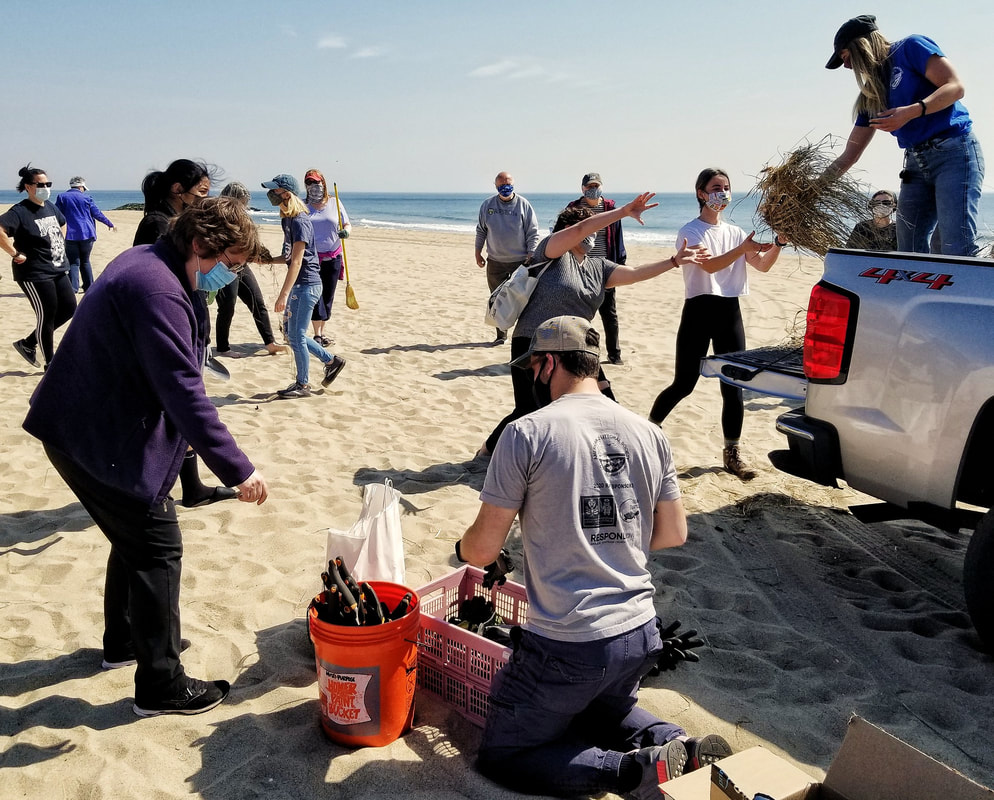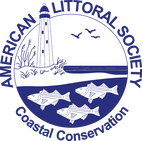|
Earth Day was big for the American Littoral Society this year. The Society hosted a week-long series of events that included some of the first involving volunteers since Covid quarantines began about a year ago. We were amazed and thankful for the outpouring of volunteer support for our cleanups and plantings during Earth Week 2021, especially with many Covid precautions still in place. Concern for protecting beaches and restoring habitat brought dozens to the warm sands of Asbury Park, a park in Vineland, a windy beach on the Delaware Bay, the chilly waters of Beaverdam Creek, and a shoreline in Jamaica Bay to lend a hand with Littoral Society projects. Volunteers have long played a crucial role in Society restoration projects, both large and small. The Society began in 1961 as a band of scuba diving hobbyists providing data to what eventually became the National Oceanic and Atmospheric Administration laboratory on Sandy Hook. The same spirit became key to the Society's efforts to engage people in caring for the coast.. At all events Covid precautions were followed, with groups kept below state regulations, staff and volunteers wearing masks, and social distancing between individuals or pods. Maintenance Day in Vineland The first effort was on at Giampietro Memorial Park in Vineland, NJ on Saturday, April 17. This maintenance day brought 10 volunteers back to a project begun two years ago that was designed to help restore vegetation and trees along Cedar Branch, a tributary of Menantico Creek that regularly floods. We had 10 volunteers to help us fix up our tree tubes and remove invasive Japanese honey suckle to keep it from overtaking our riparian buffer. Initial planting of 1,200 trees and shrubs was done in the spring of 2019 with the help of the Vineland Environmental Commission, Vineland HS Environmental Club, and Restoration Corps. In addition to fixing tree tubes, which help protect saplings from browsing deer, volunteers helped remove invasive Japanese honey, which could choke the new plants. With proper care, this riparian buffer will eventually help reduce the effects of flooding along the stream and help the surrounding area recover more quickly from such events. The project was funded by the William Penn Foundation, National Fish and Wildlife Foundation, and the Roots for Rivers Grant program. Click here to learn more about the work at Giampietro Park. Dune Grass Planting at Reeds Beach On Earth Day itself (April 22), more than a dozen volunteers joined us at Reeds Beach in Middle Township, NJ to plant dune grass. Grass was planted on a beach berm recently replaced by the Littoral Society. The berm was breached by storm surge last year during horseshoe crab spawning season, which resulted in hundreds of crabs being swept into the marsh behind the beach – where they likely would have died without human intervention. Similar sand placement took place at two other beaches recently and will be followed up with grass planting, which is part of ongoing efforts by the Littoral Society and partners to restore and protect Bayshore beaches for horseshoe crabs, migrating shorebirds, and local communities. Work began on restoring beaches along New Jersey’s Delaware Bay after many were devasted by Hurricane Sandy in 2012. In addition to replacing sand, the Society and partners also installed a series of intertidal oyster reefs designed to help protect those beaches from wave erosion. Click here to learn more about the Littoral Society's work on the Delaware Bayshore. Dune Grass Planting in Asbury Park On Saturday, April 24, the Littoral Society held two volunteer events, the first on the beach in Asbury Park, NJ and the second at our living shoreline project in Point Pleasant, NJ’s Slade Dale Nature Preserve. In Asbury Park roughly 50 volunteers turned out in beautiful spring weather to help plant dune grass near the site of the old casino. Thanks to the donation from the Plant Materials Center in Cape May (NJPMC), we were able to plant over 3,000 culms of American. The dune that volunteers worked to restore was built up over the years by a resident of Asbury Park who has worked over the last 11 years to plant native species, recycle Christmas trees, and protect the dune. The event was through the Littoral Society’s Beachgrasses in Classes program, which begins with interactive presentations in New Jersey schools about the important role dunes play in protecting our coast from storms and flooding. The program typically concludes in April with students participate coming to a Jersey Shore beach to plant beachgrass. We will monitor the progress of this dune over the coming years, while looking for opportunities to do more work at the site. Click here to learn more about the Littoral Society Beachgrasses in Classes program. Living Shoreline Project at Slade Dale Nature Preserve The last of our Earth Week events brought eight hardy volunteers to help enhance and expand the branchbox breakwaters constructed in 2019 as part of a living shoreline project. Also supporting the efforts was Point Pleasant's mayor, council, Borough administrator, and environmental commission. Volunteers waded into the cold water of Beaverdam Creek to place recycled Christmas trees between cribbing, where they will help reverse erosion that has been eating away at the shoreline for a century. The structures will help slow water flowing through the eroded area and capture sediment carried by the current. The Sanctuary’s pine-oak forest, hardwood swamp, and salt marsh provide a space of protected wilderness in an otherwise heavily developed coastal area of NJ. The salt marsh at Slade Dale helps protect uplands from flooding during storms. It also provides nursery habitat for fish, and foraging habitat for birds such as osprey, egrets, and bald eagles. The shoreline has eroded approximately 300 feet since 1930, and almost all low marsh habitat has been lost. Sometimes referred to as nature-based, green, or soft shorelines, living shorelines use natural materials such as plants, sand, or rock to stabilize the shoreline, reduce erosion, and provide valuable habitat. They also tend to be far less expensive to construct and maintain that hard structures. Living shorelines are an alternative to hardened shoreline structures such a bulkheads and seawalls. Unlike hard structures, which impede the growth of plants and animals, living shorelines grow over time. The Littoral Society continues to conduct biological monitoring around the site to help determine how the living shoreline at Slade Dale is affecting animal life. Thanks to additional funding from the US Fish and Wildlife Service, new cribbing was added this year to the existing breakwater. Project partners include: New Jersey Corporate Wetlands Partnership, Borough of Point Pleasant, The Nature Conservancy, Point Pleasant Rotary Club, and Princeton Hydro. Click here to learn more about the Littoral Society’s work with living shorelines, including the one at Slade Dale. Earth Day Cleanup in Howard Beach, NY To finish up the week, on Sunday, April 25 a diverse group of individuals and organizations joined the Littoral Society for a shoreline cleanup in Howard Beach's Spring Creek Park. Partners in the work day were the Jamaica Bay-Rockaway Parks Conservancy, Resorts World Casino, Poppa & Momma Jones Garden, Starbucks, Pacific Program Management, super-cleaner Alex Betser, and Khalsa Aid-USA, which is part of the Sikh-sponsored International humanitarian relief organization Khalsa Aid International. Approximately 50 volunteers braved a cool and cloudy day to join us in the park. They removed 68 bags of trash and marine debris, totaling nearly 2,000 pounds in weight. Click here to learn more about our work in New York City's Jamaica Bay. Comments are closed.
|
Archives
July 2024
Categories
All
|


